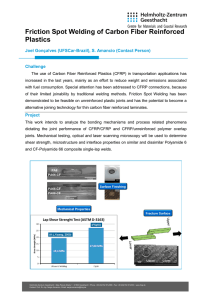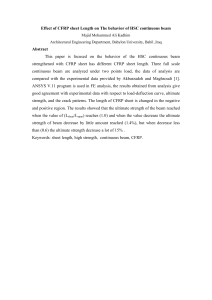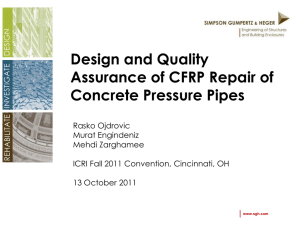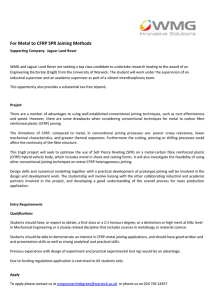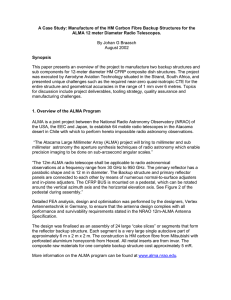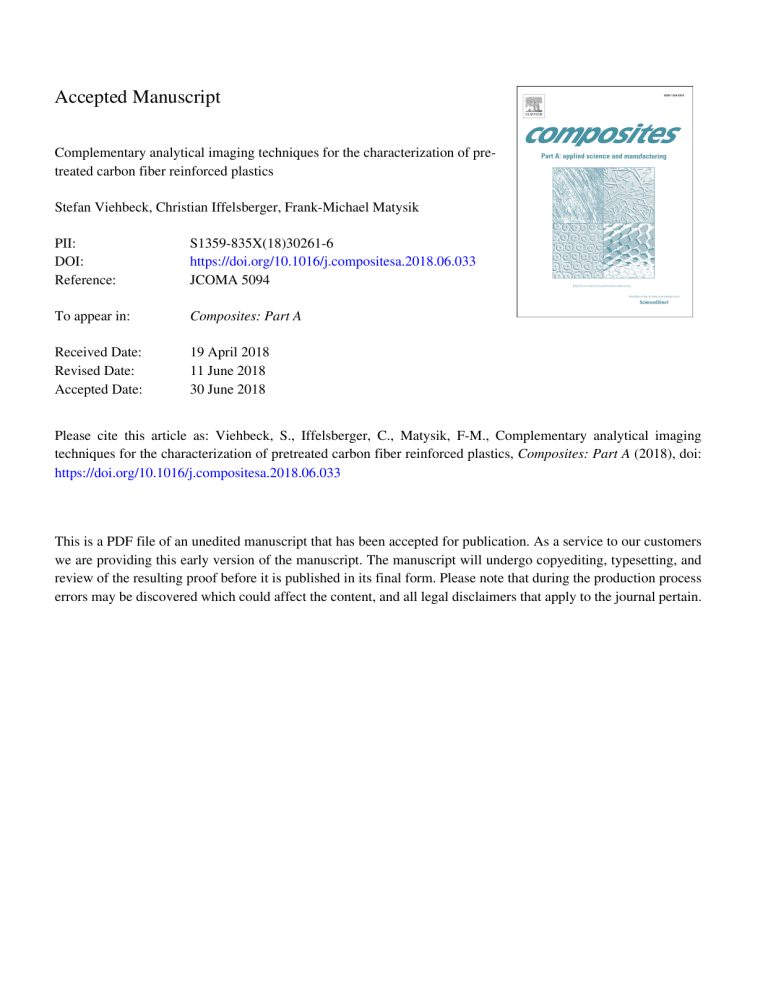
Accepted Manuscript Complementary analytical imaging techniques for the characterization of pretreated carbon fiber reinforced plastics Stefan Viehbeck, Christian Iffelsberger, Frank-Michael Matysik PII: DOI: Reference: S1359-835X(18)30261-6 https://doi.org/10.1016/j.compositesa.2018.06.033 JCOMA 5094 To appear in: Composites: Part A Received Date: Revised Date: Accepted Date: 19 April 2018 11 June 2018 30 June 2018 Please cite this article as: Viehbeck, S., Iffelsberger, C., Matysik, F-M., Complementary analytical imaging techniques for the characterization of pretreated carbon fiber reinforced plastics, Composites: Part A (2018), doi: https://doi.org/10.1016/j.compositesa.2018.06.033 This is a PDF file of an unedited manuscript that has been accepted for publication. As a service to our customers we are providing this early version of the manuscript. The manuscript will undergo copyediting, typesetting, and review of the resulting proof before it is published in its final form. Please note that during the production process errors may be discovered which could affect the content, and all legal disclaimers that apply to the journal pertain. Complementary analytical imaging techniques for the characterization of pretreated carbon fiber reinforced plastics Stefan Viehbeck, Christian Iffelsberger and Frank-Michael Matysik* Institute of Analytical Chemistry, Chemo- and Biosensors, Faculty of Chemistry and Pharmacy, University of Regensburg, Universiätsstraße. 31, 93053 Regensburg, Germany stefan.viehbeck@ur.de, christian.iffelsberger@ur.de, frank-michael.matysik@ur.de Abstract In this work the complementary characterization of pretreatment techniques for adhesive bonding of carbon fiber reinforced plastics (CFRP) is presented. Industrial CFRP plates were pretreated with laser, plasma and corundum blasting abrasive techniques followed by chemical activation. The combined use of atomic force microscopy and chemical force microscopy enabled the characterization of the surface morphology and the specific adhesion force between a chemically functionalized cantilever and the pretreated surfaces simulating the adhesive bond. Complementary measurements with scanning electrochemical microscopy and X-ray photoelectron spectroscopy supported the experimental findings and delivered additional information about the chemical structure of the surfaces. A comparison of experimental data of 1 mechanical tensile shear strength measurements and the applied analytical methods revealed a valid correlation of microscopic and macroscopic techniques. Keywords: Carbon fibers, Adhesion, Surface analysis, Scanning probe microscopy This research did not receive any specific grant from funding agencies in the public, commercial, or not-for-profit sectors. Introduction Carbon fiber reinforced plastics (CFRP) represent an attractive class of composite material consisting of carbon fibers immersed in a surrounding plastic matrix. The combination of the materials can strengthen their individual properties so that CFRP possess a greater ratio of modulus and tensile strength to their weight, a lower thermal coefficient and a higher internal damping compared to steel or lightweight alloys such as aluminum or titanium[1]. These characteristics lead to a broad field of commercial and industrial applications including military and commercial aircrafts, automotive, space and sporting goods[2] to name just a few examples. In the automotive industry CFRP components are used to construct body parts, chassis or engine components of lighter weight and with a better stability. The special chemical composition of workpieces consisting of CFRP requires different joining methods than conventional aluminum, steel or iron parts. Riveting, welding or screwing are not suitable for composite lightweight car manufacturing[3]. In addition to that, adhesive bonding won’t adhere properly on a recently manufactured CFRP part. Since large scale and automated production/compression tools require release agents and thereby contaminate the surface of the manufactured parts. Different pretreatment techniques are used to remove the release agent and activate the surface to enable adhesive bonding. The quality aspect of the CFRP bonding is regarded as a crucial safety issue. Thus, new methods for quality evaluation are needed. 2 Currently only macroscopic measurements such as tensile shear strength and peel tests are applied to evaluate the adhesive bonding[4]. The surface is evaluated according to the fracturing and conclusively regarding the efficiency of the surface pretreatment technique. For detailed information on the impact of the surface pretreatment techniques and possible consequences for the adhesive bonding, further investigations and new analytical methods must be established. In scanning probe microscopy, the information is generated through interactions between a probe, which is scanned across a substrate. The result of this measuring process is expressed as an image[5]. Beside the topographical mapping[6] atomic force microscopy (AFM) possesses the potential for the detection of interacting forces between the cantilever and a surface[7,8]. Especially for biochemical applications this measuring mode is often combined with a chemically modified cantilever[9]. Using this chemical force microscopy (CFM) recent studies show the specific interaction of functional groups and a biolayer[10]. The strength of AFM, the atomic[11,12] or molecular[13] resolution, is often compromised by the restriction to relatively small surface areas. For studying atomic or molecular effects and correlating them with macroscopic surface properties the uniformity of the studied surface is a prerequisite. From the practical point of view the microscopic surface properties are often determined by many various effects occurring at different spots across the surface. This aspect is a limitation of many highresolution scanning probe techniques for studying workpieces at industrial scale and size. The lack of representative characterization of larger surface areas can be considered as a disadvantage of AFM in the context of industrial applications. Scanning electrochemical microscopy (SECM), developed and characterized by A.J. Bard and coworkers[14], is an alternative scanning probe technique. SECM has found a wide range of applications ranging from biological surfaces[15,16] to novel inorganic materials[17]. Usually the studied substrate is fixed in an electrochemical cell and immersed in a solution containing an 3 electroactive compound as mediator substance. In the amperometric measurement mode the current of an electrochemical reaction occurring at the UME is used as signal to generate analytical information about the (electro)chemical activity and/or topographical details of the scanned surface, in a noninvasive way[18]. In SECM the probe is an ultra-microelectrode (UME) with an electrode diameter of 25 µm or less resulting in a limited resolution compared to AFM. SECM is well suited for studying properties of inhomogeneous surfaces within areas of a few square mm [19]. This is particularly attractive for surfaces which can hardly be characterized by optical methods. In addition, surfaces exhibiting regions with different (electro)chemical properties like CFRP are ideal substrates for SECM studies. With its ability to scan across rather large surface areas SECM provides additional information to AFM (surface morphology and the electrochemical activity which correlates with the material composition of the sample surface in particular carbon fiber and epoxy matrix). A classical amperometric measuring principle is the feedback mode[14], with its two possibilities to influence the signal. In negative feedback, isolating surface regions hinder the mass transport of the mediator towards the UME resulting in a decreased current. A conductive substrate, however, leads to an enhanced current due to redox cycling between probe and substrate. As with other scanning probe techniques the resolution of the SECM depends on the probe size. Mathematical expressions for the analytical treatment of the measured currents are described in literature[20] and a comprehensive review of applications and experimental parameters for SECM studies was published recently by Polcari et al.[21]. Further surface techniques such as X-ray photoelectron spectroscopy[22, 23] or ToF-SIMS[24] complement previous methods with information on the chemical composition of the surface. In this work, advanced scanning probe techniques such as AFM/CFM and SECM were used for the characterization of the surface of CFRP plates and to correlate the effects of different activation procedures such as corundum blasting, plasma and laser activation prior to chemical 4 activation of the CFRP/CFRP bonding. X-ray photoelectron spectroscopy was applied for additional characterization the chemical composition of the CFRP surface. Experimental Chemicals & Materials Industrial CFRP plates, a commercially available material (Rhein Composite GmbH), were used after a resin transfer molding process. Different pretreatment techniques were applied to activate the CFRP surface and to remove the release agent and surface contamination. In detail, the following mechanical pretreatment methods were applied: (i) corundum blasting (4-5 bar, 120 grit), (ii) CO2-laser activation ( = 10.6 µm with 80 W), and (iii) atmospheric plasma treatment (~200 °C with 10 kV). All techniques were applied with optimized settings as used under industrial conditions for comparable composites. In addition to mechanical pretreatment a chemical activator[25] (e.g. organometallic compound) was subsequently used to activate functional surface groups and to catalyze the reaction of an adhesive to the surface. The AFM and CFM studies were done either after mechanical pretreatments or after mechanical pretreatments combined with chemical activation. Prior to all scanning probe experiments the CFRP plates were cut into squares with an area of a few square cm. The obtained squares were cleaned with ultrapure water and isopropanol (MS grade, Merck KGaA, Darmstadt, Germany). For a better correlation of the measured area with the different analytical techniques the examined surface was restricted by placing a square (1 cm2) of a pierced (Ø 2.1 mm) silicone foil on the CFRP surface. The foil had a thickness of 100 µm (Elastosil, Wacker Chemie AG, Burghausen, Germany). The roughness of the corundum blasting treated sample made a fixation of the silicone foil with a fast curing 2-componenent 5 epoxy resin (UHU GmbH & Co. KG, Buhl, Germany) necessary. All imaging experiments were performed within the restricted area. For all SECM experiments an aqueous solution of 1.5 mM ferrocene methanol (FcMeOH, 99%, ABCR, Karlsruhe, Germany) as mediator and 0.2 M KNO3 (analytical grade, Merck KGaA, Darmstadt, Germany) as supporting electrolyte were used. The solution was prepared in ultrapure water with a resistivity higher than 18 MΩcm-1 (membraPure, Bodenheim, Germany). As adhesive system a two-component polyurethane mixture (1:1) was used. The first component was formulated as a multicomponent polyol mixture[26]. A prepolymeric alcohol functionalized polybutadiene mixture (52.5 w.%, Polyvest EP HT, EVONIK Resource Efficiency GmbH, Marl, Germany) was used as reactive polyol. Thiodiethanol (9.0 w.%, Fluka Analytical) was used as chain extending component. The filler, kaolin (35.7 w.%), and the adhesion agent, trimethoxysilan (0.4 w.%), were obtained from Sigma-Aldrich. Dimethoxypolysiloxan (0.04 w.%, Sigma-Aldrich) was used as antifoaming agent. Pentaerythrit (2.0 w.%, Sigma-Aldrich) was used for crosslinking. To increase the reaction speed zirconium(IV)acetylacetonate was used as catalyst (0.4 w.%, Sigma-Aldrich)[27]. All components were homogenized with a Thinky Mixer ARE 250 (Thinky corp., Tokyo, Japan) for 2 minutes at 2000 rpm. The second component was a prepolymeric MDI isocyanate mixture (DOW Chemicals). Each component was filled in a cartridge and applied with the help of a twocomponent adhesive gun with multi-chamber mixing nozzle. Instrumentation & Measurements All AFM measurements were done with a commercial AFM (Nanosurf - FlexAFM). The topographical measurements were done in tapping mode and with Tap300Al-G cantilevers and the force measurements with Tap300GB-G and HQ:NSC19/Cr-Au cantilevers. For each 6 cantilever calibrations of the deflection-sensitivity and the spring constant were done. The modification with functional alcohol groups was done via a self-assembled monolayer (SAM) process (Figure 1 B). For this a 5 mM solution of 11-mercapto-1-undecanol in ethanol (Sigma Aldrich) was used. To facilitate the handling, the cap of a micro vial was used and provided an ideal storing space for the cantilever and the thiol solution. The respective vial was filled with argon gas and used as cap to assure a clean reaction environment and was stored for 48 hours (supporting information – S1). XPS measurements were done to verify a successful monolayer formation (supporting information – S2). During CFM measurements, the functionalized cantilever approaches the surface with a constant speed and the force of interactions (e.g. van der Waals interactions) between the surface and the cantilever is detected. At a certain distance the cantilever is deflected and attracted to the surface, which can be seen in a force distance diagram. During the retracting process the cantilever interacts with the surface and is retarded due to adhesion forces. Consequently, two issues are obtained with force spectroscopy – the attractive forces for approaching the surface and the adhesion forces for retracting the cantilever[28]. With functionalized cantilevers specific interaction forces are detected (Figure 1 A). All AFM experiments were performed within an acoustic enclosure, defined laboratory environment and an active damping system to ensure reproducible results. Figure 1. SECM imaging was performed with a commercial SECM system CHI 920C (CH Instruments, Austin, USA) in a two-electrode setup with a Pt wire (Ø 0.5 mm) as counter and quasi-reference electrode. All potentials refer to this quasi-reference electrode. A Pt-disk ultra-microelectrode with an electrode diameter of 25 µm and an RG of 2-3 was used as SECM probe. The probe was 7 fabricated according to the procedure described elsewhere[17]. Prior to the imaging the substrate was levelled until a tilt less than 10 µm per mm2 was achieved. The imaging for the reference, laser- and plasma-activated sample was performed at a tip-to-substrate distance of d< 10 µm, according to the measured current (IM) of 60% in relation to the current measured in the bulk phase (I∞). For the corundum blasting treated sample IM was 125% relative to I∞ corresponding to a tip-to-substrate distance of about 17 µm. The scan speed was 100 µm s-1 with a pixel size of 4 µm. After imaging by scanning probe techniques optical images of the studied area were taken using a Leica M205 C stereo microscope. Tensile shear strength experiments: For macroscopic characterization, tensile shear strength measurements were conducted. For all tensile shear tests the substrates were cut into plates with a width of 45 mm and a length of 100 mm. The adhesive was applied onto the two substrates with a two-component adhesive gun and a multi chamber mixing nozzle. The two plates overlapped and adhered with an area of 45 mm x 20 mm. After 7 days of curing the complementary ends of both plates were fixed in the tensile shear testing device and sheared with a constant speed of 0.4 mm s-1. Five independent measurements were done and the result is calculated as mean value. XPS experiments: X-ray photoelectron spectroscopy (XPS) was performed with a commercial system Phi 5000 VersaProbe III (Ulvac PHI, Hagisono, Chigasaki, Kanagawa, Japan). The same samples as used for the SECM experiments were studied at several positions with an incoming Al-K X-Ray of 100 µm with 100 W and 20 kV. First, a survey spectrum was measured to study all components on the surface. Afterwards a detail spectrum with 3 spots on each sample for C1s (278-298 eV), O1s (523-543 eV), N1s (391-411 eV), Si2p (94-114 eV) and Sn3d5 (480-500 eV) was recorded. 8 Results & Discussion Untreated CFRP surface. The optical characterization of the untreated CFRP plate is shown in Figure 2 A. It shows surface defects induced by mechanical stress. As expected, in the scanning electrochemical microscopy image (Fig. 2 B), recorded with a 25 µm UME in 1.5 mM FcMeOH (bulk phase current of I∞≈ 5.5 nA, supporting information, Figure S5), the predominant negative feedback signal (decreased current due to hindered mediator diffusion towards the UME at an insulating surface) indicates a complete isolation of the carbon fiber by the epoxy resin. At spots where the epoxide layer is damaged the exposed carbon fibers show a positive feedback effect (increased current due to redox mediator recycling between the UME and the conductive surface). The adhesion force measured before the chemical activation (Fig. 2 C) was predominantly in the range of 10 to 25 nN at some spots adhesion forces of up to 60 nN were measured. After chemical activation the chemical force measurements (Fig. 2 D) showed an increase for the adhesion at the examined area proving the effectiveness of the chemical activation process. Figure 2. Plasma pretreated CFRP surface. In case of plasma activation the optical image shown in Figure 3 A indicates an increased roughness and topographical changes of the CFRP surface associated with several surface defects. With the SECM (Fig. 3 B) a significantly increased current is shown in the plasma pretreated area. The intense energy of the plasma burned the epoxy resin and exposed carbon fibers at the outermost layer. Thus, the fibers are clearly imaged by a positive feedback response. The diameter of the 7 µm carbon fibers is magnified by the larger probe diameter of 25 µm. The 9 generally increased current within the activated area could be derived from graphite depositions due to pyrolysis of the epoxy resin. Further surface defects can be seen in the SECM image. For both AFM images (Fig. 3C, Fig. 3D) a localization within a defined area of the SECM image was possible. The topographical information gained with AFM indicated an increased roughness for the plasma activated area (Fig. 3 C-1) with a carbon fiber of about 7 µm in width (Fig. 3 C-2). Regarding the surface and the adhesion force, no significant influence can be found between the fiber and the detected forces. However, the topographical image of the plasma activated area correlates well with a slightly increased adhesion force of 30-50 nN which compares to forces of 20-30 nN (Fig. 3, C-3) for partially activated areas. Thus, the overall adhesion force in the plasma activated area is significantly increased. In addition, several spots with adhesion forces up to 140 nN were detected within the plasma pretreated area. With additional chemical activation 3 D chemical force microscopy indicated a higher overall adhesion force of 50-70 nN and various areas with forces larger 200 nN correlating to the topographical image of the plasma influenced spots were found. Figure 3. Laser pretreated CFRP surface. Compared to the smooth appearance of the untreated CFRP, the laser pretreatment resulted in exposing single carbon fiber strands and in a grooved surface structure (Fig. 4 A). This optical change correlates with the examinations reported in literature[29]. In the SECM image (Fig. 4 B) exposed carbon fiber strands are indicated by a positive feedback current of up to 7.8 nA. The line by line pretreatment using the laser is clearly visible, showing the limited effectivity of a linear laser activation. Smaller currents in wide areas of the image between the fiber strands reflect the rough topography which is also shown in the 10 AFM images (Fig. 4 C, Fig. 4 D). A reduction of the positive feedback by isolating areas of resin could also decrease the measured current. The adhesion force measured before the chemical activation (Fig. 4 C) was slightly increased compared to the untreated CFRP. After chemical activation (Fig. 4 D) an increased overall adhesion comparable to the untreated CFRP was detected. Interestingly, within the imaged grooves a strong increase in the adhesion force caused by a higher amount of activator could be seen. In all images the line structure of the laser induced impact can be seen. Figure 4. CFRP surface pretreated by corundum blasting. With corundum blasting pretreatment a significant mechanical impact can be observed in the microscopic image (Fig. 5 A). In contrast to laser pretreatment an increased erratic roughness was found. The electrochemical activity (Fig. 5 B) was drastically increased reflected by an average feedback current of 7 nA and maximum currents up to 12 nA. Only small areas show a negative feedback which can be assigned to regions still covered with epoxy resin. The topographical inhomogeneity is also shown in the AFM images (Fig. 5 C, Fig. 5 D) with a maximum roughness of 8.4 µm. Compared to the untreated substrate the adhesion increases on several spots to 50-80 nN (Fig. 5 C). The positive influence of the corundum blasting pretreatment is shown after applying a chemical activator (Fig. 5 D). A maximum of 1.3 µN and an overall increased adhesion force within multiple activated areas of 100-250 nN were measured. Compared to the previously discussed activation techniques the adhesion forces were clearly enhanced and were distributed more homogenously over the surface. Figure 5. 11 XPS investigations. To study the influence of the chemical composition of the CFRP surfaces XPS measurements were carried out (Table 1). The reference sample and the corundum blasting pretreated surface showed the highest amount of carbon. It was found that plasma and laser pretreated surfaces exhibited a high amount of oxygen. For further evaluation the binding state of the carbon was examined (Fig. 6). Notably, the reference CFRP surface (Fig. 6 A) was the only one with an intact epoxy layer represented by bound ester groups. The increased carbon signal can be deduced from surface contamination. Laser and plasma pretreatments (Fig. 6 B, Fig. 6 C) led to free functional groups, such as alcohol and carboxyl groups. However, the analysis of the binding state of the corundum blasting pretreated surface indicated that the amount of alcohol groups was twice as much compared to the other pretreatments. Without any pretreatment, the surface is non-reactive due to the lack of free functional groups. Laser and plasma pretreatment have a similar impact on the surface, generating reactive carboxyl and alcohol groups. The highest density of functional groups was generated with corundum blasting pretreatment. Depending on the distribution and the density of reactive groups an increased adhesion force is expected. Table 1. Figure 6. Macroscopic mechanical tests. The tensile shear test was optically evaluated regarding the fracturing of the adhesive (Table 2). The samples without any mechanical pretreatment but with chemical activation (Fig. 7 A) showed an adhesive failure of 70% (n = 5). For plasma pretreatment with chemical activation (Fig. 7 B) an adhesive detachment of 15% (n = 5) was 12 found and for laser pretreatment with chemical activation (Fig. 7 C) the test showed an adhesive fracture of 35% (n = 5). The different pretreatment techniques showed an improvement of the bonding between adhesive and CFRP. For corundum blasting with chemical activation (Fig. 7 D) a 100% cohesive fracturing was found. Figure 7. Table 2. Conclusion The combination of optical microscopy with electrochemical imaging via SECM and adhesion force imaging via CFM was proven to be suitable for the evaluation of CFRP surface characteristics and for studying the influence of activation techniques in the context of adhesive bonding. With CFM a clear increase of adhesion forces after chemical activation of the substrate was identified and assigned to an enhancement concerning the reaction of the adhesive with the surface. With XPS the chemical activity of the substrate surface was studied supplementing the microscopic characterization. SECM imaging revealed the exposure of carbon fiber strands and enabled the characterization of the pretreatment methods for larger surface regions. The results of the macroscopic fracturing tests correlated well with the results of the advanced microscopic imaging techniques. The corundum blasting pretreatment combined with chemical activation was found to be the most effective pretreatment protocol for reliable adhesive bonding. All imaging techniques applied in this study added information for a better understanding of micro and macroscopic effects influencing the surface characteristics of CFRP substrates. Thus, the effectiveness of a bonding between CFRP substrates and adhesive can be foretold based on combined information derived from the analytical techniques applied in this report. 13 Appendix Supplementary files Figure S1. Preparation of self-assembled monolayer on cantilever tips. Figure S2. XPS spectra of unmodified AFM cantilevers and cantilevers with SAM modification used for CFM measurements. Figure S3. AFM adhesion measurement of a roughened and chemically activated CFRP surface. (A) Force spectrum using a cantilever with self-assembled monolayer functionalization. (B) Force spectrum with gold cantilevers without functionalization. Figure S4. XPS spectra of CFRP surfaces after applying different pretreatment methods. Figure S5. Cyclic voltammogram using a SECM probe with a diameter of 25 µm (1.5 mM FcMeOH with 0.2 M KNO3, Estart= -0.2 V, Evortex= 0.3 V, scan rate: 50 mV s-1). Inset: Optical micrograph of the SECM probe. References [1] Bhagwan D. Agarwel, Lawrence j. Broutman, Chandrarashekhara K. Analysis an Performance of Fiber Composites. 3rd edition. John Wiley & Sons, 2006. [2] Zhang Q. The “Black Revolution” of sports equipment: Application of carbon fiber reinforced plastics (CFRP). AMM 2013;440:69-73. [3] Rajakumar IPT, Hariharan P, Vijayaraghavan L. Drilling of carbon fibre reinforced plastic (CFRP) composites - a review. Int J Mater Prod Technol 2012;43:43-67. [4] Ebnesajjad S, Landrock AH. Adhesives technology handbook. 3rd edition. William Andrew, 2014. [5] Wiesendanger R. Scanning probe microscopy and spectroscopy: methods and applications. Cambrige: Cambridge University Press, 1994. 14 [6] Binnig G, Quate CF. Atomic Force Microscope. Phys Rev Lett 1986;56:930–933. [7] Leckband D, Israelachvili J. Intermolecular forces in biology. Q Rev Biophys 2001;34:105–267. [8] Nair SS, Wang S, Hurley DC. Nanoscale characterization of natural fibers and their composites using contact-resonance force microscopy. Compos Part A Appl Sci Manuf 2010;41:624–631. [9] Dürig U, Stalder A. Adhesion on the Nanometer Scale. Phys. In: Physics of Sliding Friction. Dordrecht: Springer Netherlands; 1996, p.299–323. [10] Raman S, Utzig T, Baimpos T, Ratna Shrestha B, Valtiner M. Deciphering the scaling of single-molecule interactions using Jarzynski’s equality. Nat Commun 2014;5:5539. [11] Boneschanscher MP, Van Der Lit J, Sun Z, Swart I, Liljeroth P, Vanmaekelbergh D. Quantitative atomic resolution force imaging on epitaxial graphene with reactive and nonreactive AFM probes. ACS Nano 2012;6:10216–10221. [12] Wastl DS, Weymouth AJ, Giessibl FJ. Atomically resolved graphitic surfaces in air by atomic force microscopy. ACS Nano 2014;8:5233–5239. [13] Dubrovin EV, Schächtele M, Klinov DV, Schäffer TE. Time-lapsed single biomolecule atomic force microscopy investigation on modified graphite in solution. Langmuir 2017;33:10027-10034. [14] Kwak J, Bard AJ. Scanning electrochemical microscopy. Theory of the feedback mode. Anal Chem 1989;61:1221–1227. [15] Bergner S, Wegener J, Matysik FM. Simultaneous imaging and chemical attack of a single living cell within a confluent cell monolayer by means of scanning electrochemical microscopy. Anal Chem 2011;83:169–174. [16] Bergner S, Palatzky P, Wegener J, Matysik FM. High-Resolution Imaging of Nanostructured Si/SiO2 Substrates and Cell Monolayers Using Scanning Electrochemical Microscopy. Electroanalysis 2011;23:196–200. [17] Vatsyayan P, Iffelsberger C, Mayorga C, Matysik FM. Imaging of localized enzymatic peroxidise activity over individual unbiased gold nanowires by scanning electrochemical microscopy. Anal Methods 2016;8:6847-6855. [18] Bard AJ, Mirkin M V. Scanning Electrochemical Microscopy. Boca Raton: CRC Press, 2012. [19] Mezour MA, Cornut R, Hussien EM, Morin M, Mauzeroll J. Detection of hydrogen peroxide produced during the oxygen reduction reaction at self-assembled thiol-porphyrin monolayers on gold using SECM and nanoelectrodes. Langmuir 2010;26:13000–13006. [20] Lefrou C, Cornut R. Analytical expressions for quantitative scanning electrochemical microscopy (SECM). Chemphyschem 2010;11:547–556. 15 [21] Polcari D, Dauphin-Ducharme P, Mauzeroll J. Scanning electrochemical microscopy: A comprehensive review of experimental parameters from 1989 to 2015. Chem Rev 2016;116:13234–13278. [22] Thomason J., Dwight D. The use of XPS for characterisation of glass fibre coatings. Compos Part A Appl Sci Manuf 1999;30:1401–1413. [23] Tao R, Alfano M, Lubineau G. Laser-based surface patterning of composite plates for improved secondary adhesive bonding. Compos Part A Appl Sci Manuf 2018;109:84–94. [24] Prickett AC, Smith PA, Watts JF. ToF-SIMS studies of carbon-fibre composite fracture surfaces and the development of controlled mode in situ fracture. Surf Interface Anal 2001;31:11–17. [25] Grunder S, Schamtloch S, Lutz A. Polyurethanklebstoffe zum Kleben von Kunststoffen. Kunststoffe erfolgreich Kleben. Wiesbaden: Springer Fachmedien Wiesbaden, 2018. p.189–206. [26] Müller B, Rath W. Formulierung von Kleb- und Dichtstoffen. Hannover: Vincentz Network, 2004. [27] Blank WJ, He ZA, Hessell ET. Catalysis of the isocyanate-hydroxyl reaction by non-tin catalysts. Prog Org Coat 1999;35:19–29. [28] Noy A, Vezenov DV, Lieber CM. Chemical Force Microscopy. Annu Rev Mater Sci 1997;27:381–421. [29] Oliveira V, Sharma SP, de Moura MFSF, Moreira RDF, Vilar R. Surface treatment of CFRP composites using femtosecond laser radiation. Opt Lasers Eng 2017;94:37–43. Figure Captions Figure 1. Schematic representation of the principle of AFM/CFM measurements (A) and functionalized cantilever (B). Figure 2. Characterization of untreated CFRP. (A) Optical image of the CFRP, the red square corresponds to the area imaged by SECM. (B) SECM false color image of the CFRP. AFM topography and adhesion force (false coloring) images before (C) and after (D) chemical activation. 16 Figure 3. Characterization of plasma treated CFRP. (A) Optical image of the CFRP, the red square corresponds to the area imaged by SECM. (B) SECM false color image of the CFRP. AFM topography and adhesion force (false coloring) image before (C) and after (D) chemical activation. The imaged areas correspond to the red squares shown in (B). The area (C-1) shows a domain which is fully activated by plasma, in (C-2) a single fiber can be seen and (C-3) is the marginal area of the plasma activation. Figure 4. Characterization of laser treated CFRP. (A) Optical image of the CFRP, the red square corresponds to the area imaged by SECM. SECM false color image of the CFRP (B). AFM topography and adhesion force (false coloring) image before (C) and after (D) chemical activation. Figure 5. Characterization of CFRP treated by corundum blasting. (A) Optical image of the CFRP, the red square corresponds to the area imaged by SECM. (B) SECM false color image of the CFRP. AFM topography and adhesion force (false coloring) image before (C) and after (D) chemical activation. Figure 6. XPS measurements of CFRP surfaces with different pretreatment protocols. C1s signals are shown for (A) reference CFRP without pretreatment, (B) laser pretreated CFRP, (C) plasma pretreated CFRP, (D) corundum blasting pretreated CFRP. Figure 7. Representative examples for fracturing of the CFRP correlated with the different pretreatment methods. 17 Tables Table 1. Quantification of surface atom distribution by XPS measurements. XPS quantification sample C1s Atom.-% reference 83,7 plasma 78,2 laser 77,2 corundum 82,7 N1s Atom.-% 0,8 1,0 1,4 2,0 O1s Atom.-% 13,2 17,5 17,5 14,8 Si2p Atom.-% 2,3 3,1 3,9 0,5 Sn3d5 Atom.-% 0,2 - C/O 6,4 4,5 4,5 5,6 18 Table 2. Tensile shear strength measurements of bonded CFRP samples pretreated with different methods. Untreated + Plasma + Laser + Corundum chemical chemical chemical blasting + chemical 70% adhesive 15% adhesive 35% adhesive 100 % cohesive 19 TOC Graphic 1
